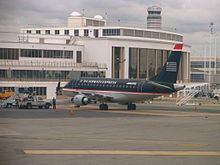Total injuries (non-fatal) 0 Passengers 11 Summary Runway incursion | Registration N872RW Date 26 May 2007 Total survivors 27 | |
 | ||
Site San Francisco Int'l AirportCalifornia, USA Type Embraer 170 Regional Jet Similar 2007 Free Airlines L‑410 cra, 2007 Paramount Airlines M, Philippine Airlines Flight 475, Air West Flight 612, 2007 Balad aircraft crash | ||
The 2007 San Francisco International Airport runway incursion occurred around 1:30 pm PST on May 26, 2007 when SkyWest Airlines (operating as United Express) Flight 5741 (SKW5741), an Embraer EMB 120 Brasilia turboprop aircraft, nearly collided with Republic Airlines (operating as Frontier Airlines) Flight 4912, an Embraer 170 Regional Jet, at the intersection of runways 1L and 28R at San Francisco International Airport (SFO), South San Francisco, California.
Contents
There were no reported injuries to occupants and no reported damage to either aircraft. Federal Aviation Administration (FAA) officials described the runway incursion as the most serious incident of its kind in at least a decade, and the National Transportation Safety Board (NTSB) initiated an investigation into the incident.
Incident
The SkyWest aircraft was arriving at SFO after a flight from Modesto, California, and was cleared for a visual approach to runway 28R by NorCal approach control. After being switched over to the tower controller, SkyWest was cleared to land on runway 28R. At the same time, the Republic Airlines aircraft, bound for Los Angeles, California was instructed to taxi into position and hold for two minutes before takeoff clearance was also granted on the intersecting runway 1L. As the landing SkyWest aircraft passed the runway threshold the Republic Airlines aircraft was cleared for takeoff. Local procedures and FAA Order 7110.65 require the local controller to wait until the landing aircraft has passed through the intersection before clearing an aircraft for takeoff on one of the intersecting runways.
Approximately 27 seconds later the Airport Movement Area Safety System (AMASS) issued an aural warning of an imminent collision, and the local controller instructed the SkyWest aircraft to stop, transmitting, "uh, sky-, skywest uhh fifty seven forty one HOLD HOLD HOLD". The SkyWest aircraft came to a stop in the intersection of runways 1L and 28R, while Republic Airlines flight lifted off and overflew it. The initial FAA tower report estimated the aircraft missed colliding by 300 feet; however the Skywest crew estimated the distance as 30 to 50 feet.
Investigation
Runway safety has been a priority concern for both the FAA and NTSB. In a March 23, 2007 press conference on runway safety the FAA Administrator Marion C. Blakey described the Tenerife disaster 30 years earlier as a "wake-up" call. Runway safety has been on the NTSB's annual list of "Most Wanted Improvements" continuously since 1990, and the NTSB held a one-day forum on runway incursions just two months earlier, on March 27, 2007.
In this case, the FAA categorized the incident's severity as "Category A", the most severe; Category A is defined as when "separation decreases and participants take extreme action to narrowly avoid a collision, or the event results in a collision." Of the previous 15 runway incursions at SFO between 2001 and 2007, none of them were more serious than Category C, defined as the situation where "separation decreases but there is ample time and distance to avoid a potential collision".
Commenting on the seriousness of the incident, NTSB spokesman Ted Lopatkiewicz noted that "We investigate probably just a handful (of incursions) a year." The NTSB officials stated that the investigation could be completed by that autumn. However, FAA spokesman Ian Gregor was quoted as saying "This wasn't a procedural issue, this was caused by a good controller with a lot of experience making a mistake", adding that since the incursion the controller had to be recertified for their job. The controller had over 20 years' experience.
SFO and AMASS
SFO was initially selected for the first test installation of the AMASS ground radar system in 1992. AMASS, which can detect and alert controllers to potential runway conflicts, was intended by the FAA to be eventually installed in 40 airports around the country. However much criticism was directed at the project for cost overruns and lengthy delays. The SFO AMASS was finally declared operational on June 18, 2001. According to AMASS technical support personnel, in a scenario such as this conflict, AMASS is designed to provide an alert 15 seconds before the aircraft reach the conflict point, and the system performed as designed. However, the NTSB has noted that while AMASS alerted in this incident, it did not alert in time to prevent the runway incursion.
As of February 2016, the NTSB continues to list the 2007 SFO runway incursion as evidence that AMASS is insufficient to prevent runway incursions, and as a result, to list a requirement for positive ground movement control on the board's "Most Wanted Transportation Safety Improvements" list.
